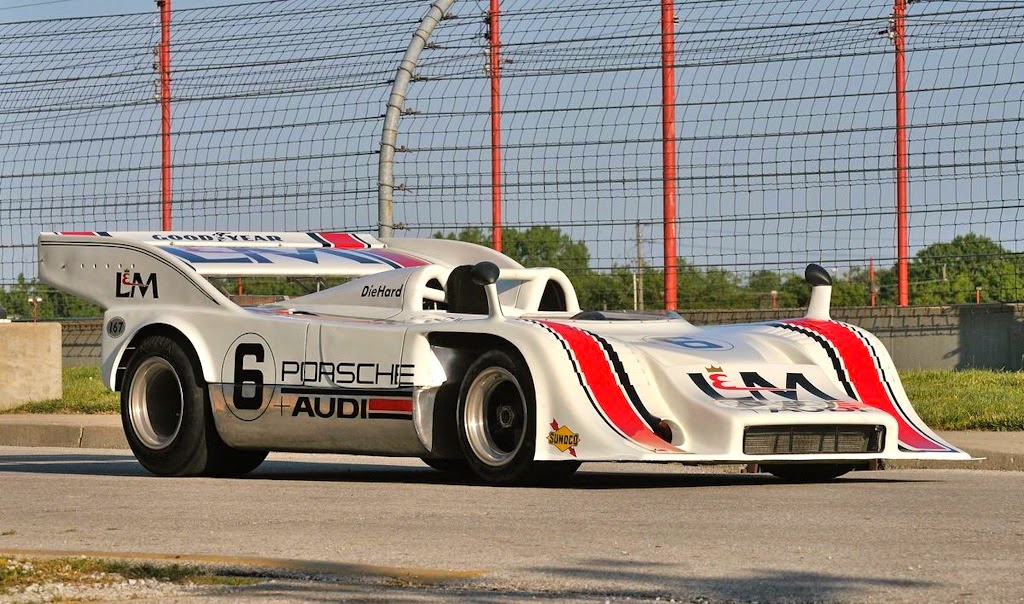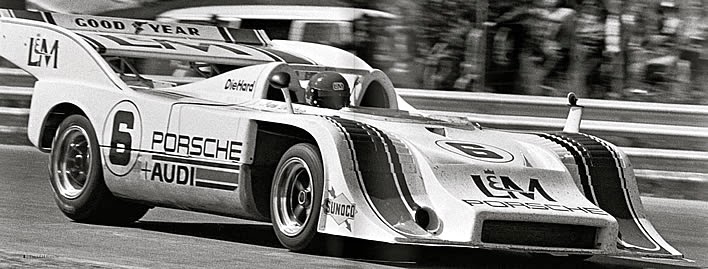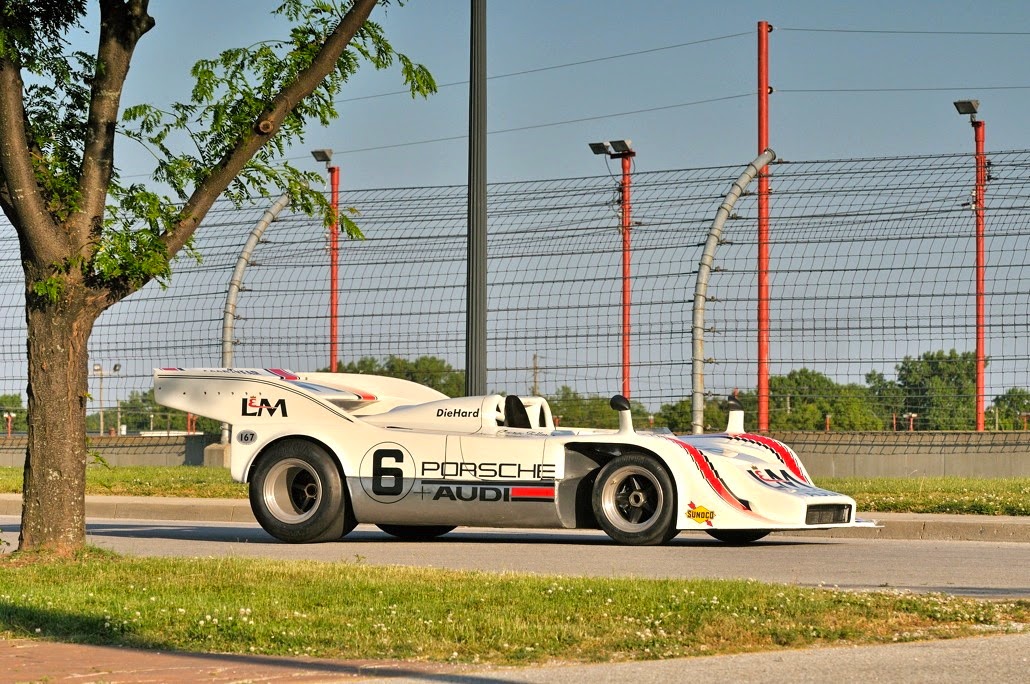Mosport International Raceway had an innocent charm that’s long been missing from today’s clinical, overly sanitized racecourses. The grass was too high. There were no sand traps.
The white line edging the course in Turn 5b (now called “Moss Corner”) was worn and
covered with gravel. The thin layer of sand covering the front straight raised a fresh
dust cloud every time a racecar roared past.
It was Sunday afternoon, June 11, 1972. John “Woody” Woodard took a dirty red shop rag from his hip pocket and wiped the oil off his hands. Woody was chief mechanic on Penske Racing’s Can Am road racing team and he couldn’t afford to have dirty hands. The team’s shirts were bright red and would show even the slightest stain. Worse yet, the massive letters on their uniforms identifying them as Penske’s “L&M Porsche – Audi” team were pure white. So were their wide leather belts.
Mechanics didn’t wear custom designed, heat resistant gloves in 1972, so Woody cleaned his hands as best he could and stuffed the rag back into his hip pocket. His driver, Mark Donohue, would be here any moment to climb into his new racecar.
Already widely considered one of America’s finest athletes, Mark Neary Donohue, Jr. was only two weeks removed from winning the world’s most prestigious automobile race at the Indianapolis Motor Speedway. He had already earned victories in the United States Road
Racing Championship, the 12 Hours of Sebring, and held the all-time record for single
season wins in the Trans-Am series.
It therefore came as no surprise when the affable 34-year-old from New Jersey won the pole position for Penske at the opening round of the Canadian-American Challenge Cup, more commonly known as the “Can Am series.”
Penske’s task was simple. His team was to unseat McLaren, who had dominated the series since 1967 and began the 1972 season as the defending champions. Denny Hulme and
Pete Revson, both household names and world-class drivers, piloted McLaren’s new
M20 racecars into the new season.
The opening race at Mosport was only minutes away and both sides of the track were crowded with spectators. Opposite the pit area near the start/finish line, a series of low, temporary grandstands had been erected to hold about ten rows of fans.
Pit lane itself was lined with photographers. One of them bent far over the wall and held a camera just inches above the track surface with his right hand, preparing to capture a magnificent shot as the field flew by on the first lap. You could do that sort of thing in 1972.
Woody leaned against the rear wing of Penske’s brand new Porsche 917/10-003 racecar until it began to roll down pit road. He had literally lived with this car since its arrival at the Penske shop the previous November. He pushed it, slowly and silently, toward the number one starting slot where it would lead the field to the green flag. He could not have known that this was the beginning of a historic five-month campaign that would forever establish the L&M Porsche 917/10 as one of the most iconic racecars in the world.
The open-cockpit Porsche 917/10 was unlike the previous coupe versions that had been competing for the past two seasons in Europe. The earlier models were loosely based on the Porsche 908, which had failed in its mission to dominate Le Mans but still proliferated at racetracks on both sides of the ocean even as development of the 917 began in July 1968.
Penske Racing had two Porsche 917/10’s available at the Mosport race. The team would eventually own three such cars during the 1972 season.
Penske’s first car was serial number 003. To race fans around the world, this car would go down in history as the famous #6 L&M Porsche. Around the Penske shop it was simply called the “three car.” To the team and the manufacturer, each car was known by its serial number, not the race number painted on its bodywork. In Porsche terminology, the car’s full identity was “917/10-003.” This was the first 917/10 received by Penske Racing and the car that the team intended to race in the first event at Mosport.
Likewise, Penske’s second car (serial number 011) was referred to as “917/10-011” in Porsche records. It was received at Penske Racing just days before the opening race of 1972 and had an experimental, lightweight magnesium chassis. It was transported to Mosport as a backup to the 003 car although it was not yet race-ready. The third car received by Penske later in 1972
was 917/10-005. Mark Donohue would drive this machine late in the season. Although
all three racecars were painted in similar livery, it was the 003 car that would go
down in history as “the L&M Porsche.”
It is vital to remember that the numbers painted on the bodywork of the cars were considered irrelevant and fluid at the time. For instance, the 003 car wore #6 for the first half of the season but was repainted as #7 after the fifth event. Within Team Penske and Porsche, the car’s “race number” was of little significance. Regardless of what number was painted on the bodywork, it was still chassis number 003.
Distinguishing the new 917/10’s from the previous 917 model was easy because, unlike its predecessor, the 917/10 was built in a spyder configuration with an open cockpit.
The fuel capacity of the new model was increased so as to eliminate pit stops during
Can-Am’s lengthy races.
Initially equipped with a naturally-aspirated 16-cylinder engine, it was determined that the new 917/10 needed more power. Porsche engineers opted instead for a turbocharged, air-cooled, flat 12-cylinder engine that was a monument to redundancy. It featured dual distributors feeding a twin spark plug system, two valves per cylinder, twin overhead camshafts and a pair of turbochargers.
The engine produced a mind-numbing 1,100 horsepower in race trim. Cranking up the turbo boost for qualifying would later produce an even more obscene 1,200 horsepower. The 917/10 represented everything for which Porsche stood. It was a technological masterpiece that sacrificed everything for speed.
The floorboard and bodywork were paper-thin and nearly weightless. The cockpit was spartan to the extreme. Overpowered with a short wheelbase, it was a nightmare to drive and demanded the utmost skill from its pilot. It relied heavily on aerodynamic grip, which is finicky and totally dependent on constantly changing atmospheric conditions such as wind and humidity.
Helmut Flegl was a young engineering graduate from Germany who had snagged a job at Porsche in the late 1960s. His first assignment was the 917 project and he had exceeded company expectations. He spoke reasonably good English and wanted to see the entire 917/10 project through to completion.
Both Roger Penske and Mark Donohue wanted a representative from Porsche to remain with the team throughout the year to act as a liaison between the automaker and the race team. Flegl was the obvious choice for the position and once again, Porsche didn’t hesitate to spend the money necessary to assure the success of their new creation. Flegl came to America for every race of the 1972 season.
“I’ve got a unique relationship in this project,” Donohue told Pete Lyons for Road & Track magazine in the spring of 1972. “A kind of relationship I’ve never had before. Helmut Flegl is, oh, sort of ‘the boss of the 917’ and he’s a man who is capable in every respect. I can talk to him, I can say things to him and he to me and we understand each other perfectly. We speak the same language, and I’ve never really had a relationship like that before. I’ve always been used to doing it all myself. This is fabulous for me. I’ve really learned a lot.”
Flegl’s mindset spoke volumes about Porsche’s commitment level. When 917/10-003 was sent to the paint booth, there was tremendous concern from the manufacturer about the weight of the paint. It was given multiple coats of white base coat, then glossy. The roll bar was painted. The overall white was complemented by wide stripes of red paint on each side stretching the length of the car and including the huge rear wing. Black trim was added to every viewing angle of the car, along with numbers and sponsor decals. Flegl was livid!
Woodard recalled Flegl’s fury when he saw the car, fully painted in its now-famous L&M livery at Mosport, for the first time: He came over and saw it and said, “My God! I’m going to get fired when I get back. You must have put thirty tons of paint on it.”
“That’s it. I’m gonna get fired.”
Such was the company’s commitment to the project. The 917/10 was Porsche’s uncompromising gamble to literally steal North America’s most important road racing title from their chief rivals. But when the green flag fell to start the 1972 Can-Am season at Mosport, Porsche’s high-tech armada was quickly humbled by nothing more than a sticky valve.
Early in the race, Donohue pulled 917/10-003 into the pits and shouted to his crew that he had no turbo boost. Valetine Schaffer, Porsche’s top man on the turbocharged V-12 engine program, looked under the rear bodywork and instantly recognized the problem. Woodard was desperately working alongside Schaffer to fix the issue in the pits, and he recalled the moment: The German engineers devised a couple of valves to try to keep the turbochargers spooled up. The valve that caused the problem at Mosport (and again two races later at Watkins Glen) was… well… I call it a “dump valve.”
When you let off the throttle it would open this valve so the turbo could still pump air. Even though it wasn’t going into the engine, it would just pump the air into the atmosphere. When you open the throttle, this valve would snap shut so that you had instant boost.
It was a slide arrangement and at first the Germans said you needed to use a special lubricant to make sure it doesn’t stick. If it sticks; the valve won’t close. That’s what happened at Mosport.
The problem was that the lubricant had picked up dirt. The dirt got into the slide mechanism and it seized, and the valve stuck open. The engine lost power and you just couldn’t get boost. There was no design problem. There was no actual part failure. It was just a slide mechanism that got clogged up with dirt and seized.
The end fix was that we just didn’t use the lubricant. It was very clean, with enough clearance that it would [open and close properly] under any conditions. After Watkins Glen, we had no more problems for the next two years.
Mark Donohue stormed back through the field but could only salvage a second place finish from what should have been a dominating win in the season’s first outing. Denny Hulme won the race in McLaren’s new Chevy-powered M20. Porsche’s opportunity to break McLaren’s five-year reign over the Can-Am series was off to an inauspicious start.
Team Penske knew they had the speed. There was no question about that. They knew they had the driver and that the problem with the dump valve was minor and solvable. But they needed some luck and so far they hadn’t had any. Three weeks later at a road course in the countryside north of Atlanta, things would get much, much worse.
Part II: The Accident – coming soon.
Stephen Cox is a racer and co-host of TV coverage of Mecum Auctions (NBCSN), sponsored by: http://boschett-timepieces.com/
http://www.mcgunegillengines.com/






